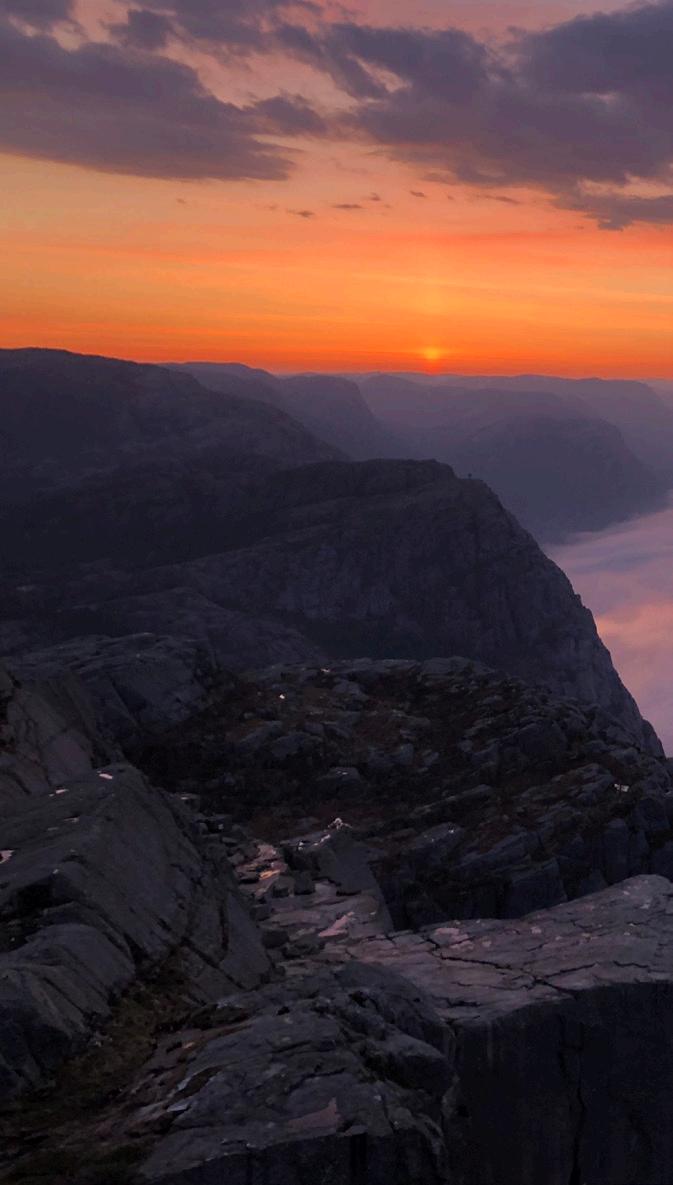
3 minute read
INTO THE WILD ON NATURE’S TERMS
Being outdoors is an important part of the Norwegian culture and identity and can often be thought of as “typical Norwegian”. Being active in nature, regardless of the weather will make you happy, try it yourself!
The right to roam (Allemannsretten)
Advertisement
Outdoor life is so important in Norway that it has a law that ensures people free access to nature. Allemannsretten is a wonderful, free public good and an essential part of Norwegian cultural heritage. In short, it gives everyone the right to travel freely on foot and skis in the wild and gives the option of camping when it is at least 150 m from the nearest house or cabin, for a maximum of two nights. Allemannsretten entitles us to many things, however, it is a privilege that also obliges us. One of our duties is to take care of nature and not disturb it, leaving nothing but footprints behind. We have a shared responsibility to take care of nature, ensuring that those who come after us can enjoy it in the same way as us. When we are traceless, we take into account nature, the animals and each other.
Your duties concerning the right to roam:
• Do not walk in cultivated fields and meadows
• Close gates behind you and do not ruin fences
• It is forbidden to use fire or light up a bonfire in forests and fields between 15 April and 15 September.
• Always remember that dogs must be on a lead – be considerate of grazing animals
• Do not disturb animals and birds, including nests and baby birds
• Take your litter back and leave nature without a trace
Sustainable outdoor life
We take care of what we love. The youth department of the Norwegian Trekking Organisation (DNT Ung) has together with POW (Protect Our Winters) Norway drawn up seven simple environmental rules for a more traceless outdoor life:
#1 Travel less, experience more
#2 Focus on experiences, not equipment
#3 Repair everything, always

#4 Eat greens
#5 Shared driving is responsible driving
#6 Be prepared for unexpected litter
#7 Show the way, be a sustainable role model
There is no such thing as bad weather, only bad clothing
The weather in our part of the country changes fast, and you can quickly experience several seasons on the same day. You can experience windy rainy days no matter what time of year you visit, and we cannot guarantee sun and heat during the summer. Therefore, it is important to be prepared. Dress according to the weather conditions and bring extra clothes in your backpack. Remember that it is always colder in the mountains than in the city. You can hike, regardless of the weather - as long as you plan well in terms of weather conditions, equipment, shape, experience and local knowledge. When you have little previous hiking experience or are unsure of the conditions, you should go with a nature guide. Nevertheless, it may be a good idea to include at least one extra day when planning a trip to our region, so that you don’t have to feel forced to do your planned hike in a stiff gale. With weather forecasts like this, it’s better to wait until the next day - rather enjoy museum visits and shopping in the meantime. If you feel you need to upgrade your hiking equipment, remember you can also rent necessary equipment from both the guide companies and frilager.no.
Our advice in terms of equipment
• Preferably use wool, then a medium layer with a wool sweater/ fleece and a windproof jacket
• Bring rain gear, a hat, mittens, and a change of clothes. A reflective vest may be a good idea, making it easier to find you in case you need help
• Good footwear is crucial – preferably hiking boots
• Bring food and drink adapted to the length of the trip
• First aid equipment
• Map, compass, GPS, and flashlight
• Bring your mobile phone, but remember that there might be places without coverage
• A wind sack is a good shelter from the weather
To prevent accidents in the mountains, the Norwegian Tourist Association and the Norwegian Red Cross have drawn up nine rules:
The Mountain Code
1. Plan your trip and inform others about the route you have selected
2. Adapt the planned route according to ability and conditions
3. Pay attention to the weather and the avalanche alerts
4. Be prepared for bad weather and frost, even on short trips
5. Bring the necessary equipment so you can help yourself and others
6. Choose safe routes. Recognise avalanche terrain and unsafe ice
7. Use a map and a compass. Always know where you are
8. Turn back in time; there is no shame in going back
9. Conserve your energy and seek shelter if necessary










